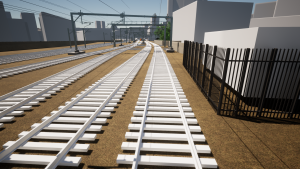Railway infrastructure is set to make up a significant proportion of construction projects over the next few decades, particularly in Europe and Asia.
With hundreds of projects in the pipeline and many contracts already awarded by governments, there is potential for technology providers, manufacturers, and contractors to benefit greatly.
But railway construction isn’t the low-tech, labor-intensive industry that it once was, so how exactly will the transition from analog to digital systems, strategic advances in data acquisition and improvements to security and precision help the industry respond to rising demand?
The European Union alone has invested over 6.5 billion euros in critical rail projects last year, while Austria anticipates a staggering 21 billion euro investment into its railway infrastructure from 2024 to 2029. This surge in investment underscores a broader trend: railways are emerging as the driving force behind public infrastructure development.
Factors such as population growth, escalating transportation and logistical demands, as well as a collaborative environmental focus on reducing CO2 emissions and increasing sustainability, are propelling a shift towards a rail-centric future. As everyone focuses on minimizing their carbon footprint, it is important to keep sustainable growth of public construction on track.
Evolution of railway infrastructure
The past decade has witnessed a monumental transition in railway construction. This digital transformation has permeated the entire construction landscape, revolutionizing data collection and management practices. While this transition encountered initial challenges, significant progress has been made, particularly in using digital technology to plug data gaps.
Digital workflows now facilitate seamless data exchange between project stages and stakeholders, resulting in enhanced project management capabilities. The volume and robustness of data is now superior to what human acquisition could ever achieve.
On the ground, advanced laser scanning technologies have emerged as invaluable tools in carrying out geotechnical assessments, providing not only construction data but an unprecedented volume of structural and geological data, too.
Enhancing efficiency and safety
Geospatial technologies play a pivotal role in enhancing the speed, accuracy, and safety of railway construction projects. The adoption of advanced surveying techniques has significantly reduced the time spent on-site for data acquisition, thereby minimizing human intervention and mitigating risks for project teams.
With streamlined data acquisition processes, project stakeholders can access critical information more efficiently, facilitating informed decision making and proactive risk management.
It is now possible to detect and predict geological patterns with greater accuracy, avoiding damage and rework, which helps reduce costs and creates a safer environment during and after construction.
Advancements in specialist technologies like deformation monitoring have enabled stakeholders to gain a better understanding and management of risk using hardware that facilitates autonomous operation of sensor equipment in the field.
Solutions like Topcon Delta deformation monitoring represent cutting-edge technological breakthroughs in railway infrastructure monitoring. The fully automated system employs predefined measurement cycles to monitor various structural elements, including bridges, tunnels, dams, embankments, and rail tracks.
Working with devices on site, the technology eliminates the need for continuous human intervention, enabling real-time monitoring and data analysis with a high level of safety. This proactive approach empowers asset owners to anticipate and address potential risks, ranging from geological uncertainties to physical damage, with pin-point precision and efficacy.
Full steam ahead
The railway construction sector is destined for greater technological innovation. Remote sensing technologies, including satellite imagery, offer promising avenues for remote infrastructure monitoring and data analysis. However, with the abundance of data generated by new technologies, the challenge lies in effectively managing and interpreting it.
While big data holds immense potential, its complexity can prove overwhelming and potentially misleading. Therefore, it is imperative to strike a balance between data acquisition and onsite assessments, and that we have clarity on what and how data should be used to produce the most favorable outcomes.
It is also essential that engineers work safely while deploying and maximizing the utility of geospatial technologies to grow the railway sector.
The growing commitment to railway infrastructure within the public construction sector signals a new era of innovation and efficiency. As investments soar and technologies evolve, railways are emerging as the cornerstone of sustainable transportation and freight logistics.
With increasing demands for railway infrastructure and the data, efficiency, and safety benefits that geospatial advancements bring to the table, the railway sector is set to revolutionize public infrastructure development – offering safer, more efficient, and environmentally sustainable solutions.








